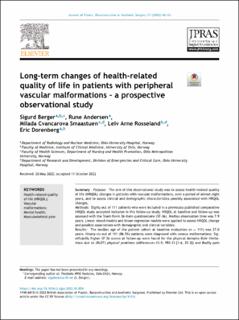| dc.contributor.author | Berger, Sigurd | |
| dc.contributor.author | Andersen, Rune | |
| dc.contributor.author | Småstuen, Milada Cvancarova | |
| dc.contributor.author | Rosseland, Leiv Arne | |
| dc.contributor.author | Dorenberg, Eric | |
| dc.date.accessioned | 2024-01-25T07:57:36Z | |
| dc.date.available | 2024-01-25T07:57:36Z | |
| dc.date.created | 2023-03-17T13:04:31Z | |
| dc.date.issued | 2023 | |
| dc.identifier.citation | Journal of Plastic, Reconstructive & Aesthetic Surgery. 2023, 77 46-53. | en_US |
| dc.identifier.issn | 1748-6815 | |
| dc.identifier.uri | https://hdl.handle.net/11250/3113681 | |
| dc.description.abstract | Purpose The aim of this observational study was to assess health-related quality of life (HRQOL) changes in patients with vascular malformations, over a period of almost eight years, and to assess clinical and demographic characteristics possibly associated with HRQOL changes. Methods Eighty out of 111 patients who were included in a previously published comparative HRQOL study accepted inclusion in this follow-up study. HRQOL at baseline and follow-up was assessed with the Short-Form 36-item questionnaire (SF-36). Median observation time was 7.9 years. Linear mixed models and linear regression models were applied to assess HRQOL change and possible associations with demographic and clinical variables. Results The median age of the patient cohort at baseline evaluation (n = 111) was 27.0 years. Ninety-six out of 111 (86.5%) patients were diagnosed with venous malformations. Significantly higher SF-36 scores at follow-up were found for the physical domains Role limitations due to (RLDT) physical problems (difference=13.5; 95% CI [1.6, 25.3]) and Bodily pain (difference=11.3; 95% CI [3.8, 18.8]). No deterioration of HRQOL was found in any domain. In multivariate analyses, female gender, muscle/bone involvement, and higher age were associated with a positive relative change in SF-36 in the domains Physical functioning, RLDT physical problems, and RLDT emotional problems, respectively. Invasive treatment was not associated with long-term HRQOL change. Conclusions Over a period of almost eight years, significant improvement of SF-36 scores was observed in the physical domains RLDT physical problems and bodily pain. Female gender, muscle/bone involvement, and higher age were associated with HRQOL improvement in certain domains. | en_US |
| dc.language.iso | eng | en_US |
| dc.relation.uri | https://reader.elsevier.com/reader/sd/pii/S1748681522005770?token=E1A6306DA385E88EE1DF315D88A23BE15D126DC33AEB1555830ECE0654CF6DC401F08AD2F2C91B1DFA3302C4D040A54D&originRegion=eu-west-1&originCreation | |
| dc.rights | Navngivelse 4.0 Internasjonal | * |
| dc.rights.uri | http://creativecommons.org/licenses/by/4.0/deed.no | * |
| dc.title | Long-term changes of health-related quality of life in patients with peripheral vascular malformations – a prospective observational study | en_US |
| dc.type | Peer reviewed | en_US |
| dc.type | Journal article | en_US |
| dc.description.version | publishedVersion | en_US |
| cristin.ispublished | true | |
| cristin.fulltext | original | |
| cristin.qualitycode | 1 | |
| dc.identifier.doi | 10.1016/j.bjps.2022.10.024 | |
| dc.identifier.cristin | 2134781 | |
| dc.source.journal | Journal of Plastic, Reconstructive & Aesthetic Surgery | en_US |
| dc.source.volume | 77 | en_US |
| dc.source.pagenumber | 46-53 | en_US |

